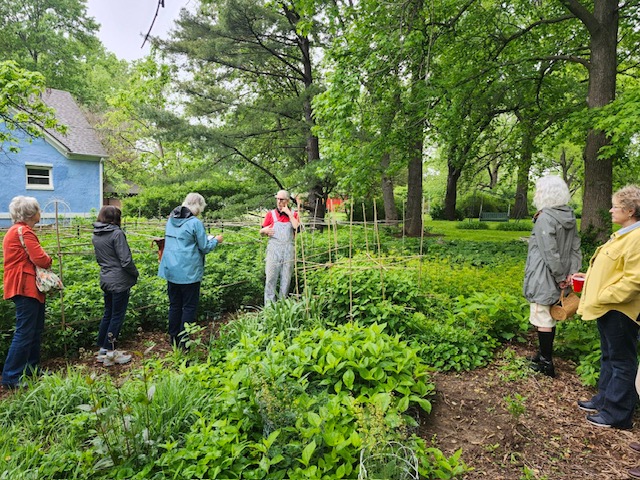
10 minute read
Delightful Gardens
Shawnee club again spotlights area plots on its popular biannual tour.
article by Jean Teller and The Garden Club of Shawnee
photos courtesy The Garden Club of Shawnee
For spring inspiration, look no further than these garden gems spotlighted by The Garden Club of Shawnee’s Garden Sampler Tour.
The popular biannual tours provide an opportunity to explore the spectacular gardens, both large and small, of Shawnee residents. This year’s tour highlights gardens belonging to the Exells, the Leitch-Hinds family, the Jorgensens, the Richardsons, the Weishaar family, and the Wilhofts. Rain or shine, the tour will take place from 9 a.m. to 5 p.m. on Saturday, June 14.
Let’s take a closer look.

A Field of Flowers
When Karla and Don Ezell moved in about 27 years ago, the 1.5 acres they now call home was a blank slate that has since become anything but empty. The first actions they took involved hauling in truckloads of dirt and constructing raised garden beds with rock walls, using rocks sourced from the neighborhood; since the property sits atop solid rock, this remediation was necessary.
They’ve planted black-eyed Susans, verbena, coneflowers, cosmos, and butterfly weed to create a colorful haven for wildlife. This year, they’ve added a section of feather reed grasses along with a bed filled with new varieties of hydrangeas. The Ezells expanded their flowerbeds and trees and included a landscaped pond, emphasizing hardy natives while allowing parts of the yard to revert to its prairie state. The acreage attracts hummingbirds, Eastern bluebirds, and countless butterflies.
When asked about the time she spends in the garden, Karla replies, “During the garden season, I always joke that it’s a full-time job! I’d say I spend at least 30 hours a week in the garden.”

Loomis Woods
For over 20 years, Christopher Leitch and Stuart Hinds have worked to transform their 1-acre lot into spectacular gardens. The Hinds-Leitch home is on land that was the site of a 1930s neighborhood and trolley line; the name Loomis Woods is derived from this earlier development. The couple combines nostalgia and science when planning and planting native perennials for year-round interest.
The garden beds, spanning over 5,000 square feet, showcase more than 75 varieties of flowering perennials, grasses, and trees. Christopher says some of their favorites include the turk’s cap lily (Lilium superburn) and the prairie dock (Silphium terebinthinaceum). “Both are native that have a reputation for being difficult to establish,” he explains. “Ours are going strong. This year, I counted 90 stems of turk’s cap; we started with six some 15 years ago.”
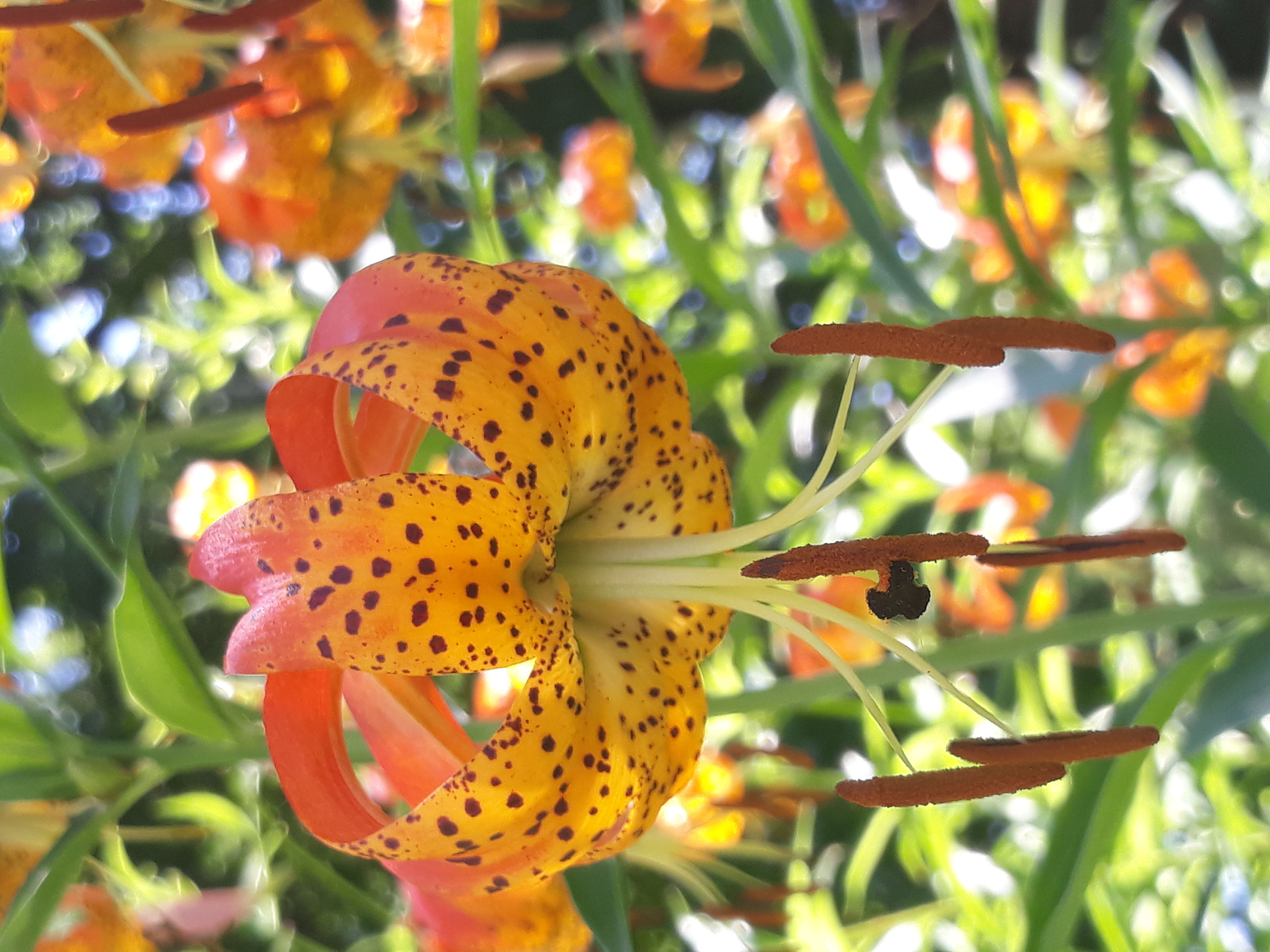
They also love the blue hyacinth planted by the previous owners. “They line the gravel drive and fill the spring mornings with scent,” he says. Visitors will also find daylilies along the street, herbs in the medians, and peonies and irises gracing the grounds, in addition to vegetable and herb beds.
They have added four plants for early spring this year: bird’s-foot violet (Viola pedata), smooth yellow violet (Viola eriocarpa), Jack-in-the-pulpit (Arisaema triphyllum), and wild leek (Allium tricoccum).
“I think the size of our gardens allows plants to naturalize on their own scale, so it’s pleasing to feel as if we have our own little national park outside the screened porch. It’s easy to get lost out there,” Christopher says.
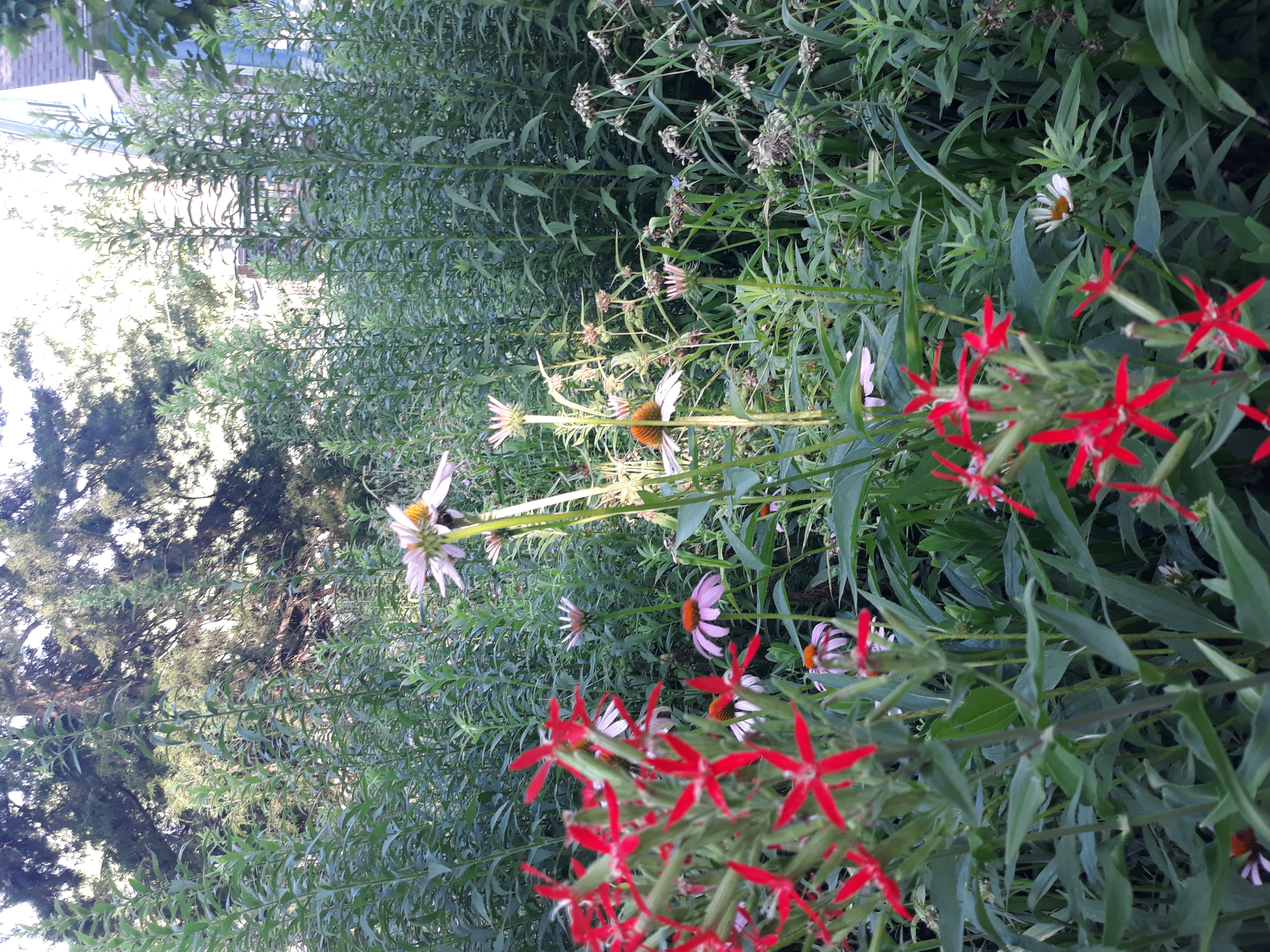

A Garden of Gifts
Laurie and Eric Jorgensen have been experimenting in their garden for more than 20 years. After moving in, they realized a barren hillside needed attention. Overlooking an 8-acre pond, the hillside became the perfect site to plant trees: pines, fruit trees, hazelnut bushes, crabapples, and redbuds. These trees not only add beauty to the property but also help stabilize the hillside.
Although most of the original trees are no longer part of the landscape (they initially planted two cherry, two plum, three peach, and two apple trees), the Jorgensens continue to experiment by adding a Star Magnolia tree, Jane Magnolia trees, and a Bracken’s Brown Beauty magnolia. A large weeping cherry tree dominates the front yard, accompanied by a Harry Lauder’s walking stick (Corylus avellana ‘Contorta’). Over the years, Laurie has received many peony bushes, which now number more than 20 scattered throughout the yard. Other favorite plants for the Jorgensens include hydrangea, iris, clematis, and hostas.
Laurie says, “Gardens cover the entirety of the foundation of the house, including a large hosta bed under the deck, two large berms in the front yard, and gardens around the perimeter of the backyard.” She also has four raised beds for vegetables.
The yard is also home to a variety of fauna. The garden has been a certified wildlife habitat since 2010, after Laurie learned about the designation during a master garden tour. In 2018, Eric added a pizza oven that has become a popular gathering place for family and friends. The oven—along with a stamped patio, fire pit, retaining walls finished in native limestone, and large limestone planters flanking the gardens—adds unique hardscape elements to this garden.

Pollinator Buffet
In an amazing effort to support the ever-decreasing numbers of pollinators, Gigi Richardson has planted a pollinator garden buffet that provides food from early spring through fall. Gigi’s garden attracts all types of pollinators: bees, butterflies (and their caterpillars), and birds, including hummingbirds.
When the family moved in during August 2020, there were some trees but no gardens. Gigi started a rose garden almost immediately, along with hydrangeas, hostas, and lilies. The front and back lawns are now a vibrant display of flowers.
In 2022, she established a butterfly garden to attract not only monarchs but also swallowtail butterflies. In 2023, she expanded the pollinator garden by removing grass and adding more nectar flowers. That year, she also registered the garden as a Monarch Waystation with www.monarchwatch.org and planted additional milkweed, native plants, and other host plants specifically for butterflies.

Small but Mighty
Marlene Weishaar has crafted a colorful sanctuary around her townhouse, creating an extraordinary entertainment spot for friends. She incorporates numerous annuals to infuse color into the patio and flower beds; she loves SunPatiens in particular for their vivid hues. The open-air patio serves as a centerpiece, featuring a tree-of-life gate designed by a family friend. While plants and garden décor envelop her home, she has also added custom-made touches to engage the senses: a handmade lattice pergola that mimics bay windows and a metal sunflower sculpture on the side of the house. “The sunflower sculpture is by Rito, a metal works artist from Topeka,” she explains. “The back gate was also created by Rito. It’s a beautiful focal point when entering the patio from the outside.”
The patio, designed by Marlene and her contractor, Mark, was begun in 2021 and completed in 2023. It was designed as two separate rooms, upper and lower.

Clematis and heirloom climbing roses have staked a claim on the pergola, and visitors will enjoy the bougainvillea, a weeping cherry tree, alliums, and cotoneaster, along with a variety of potted flowering plants.
“I have a number of potted plants in the patio area. These include three large concrete urns with Prince Tut ornamental grass as the centerpiece,” she says. “The grass is surrounded by coleus, vinca, fan flowers, to name a few. The lower patio bird bath is surrounded by Kimberly Queen ferns and color coleus. The upper level of the patio contains more tropical plants such as palms, cannas, and mandevilla.”
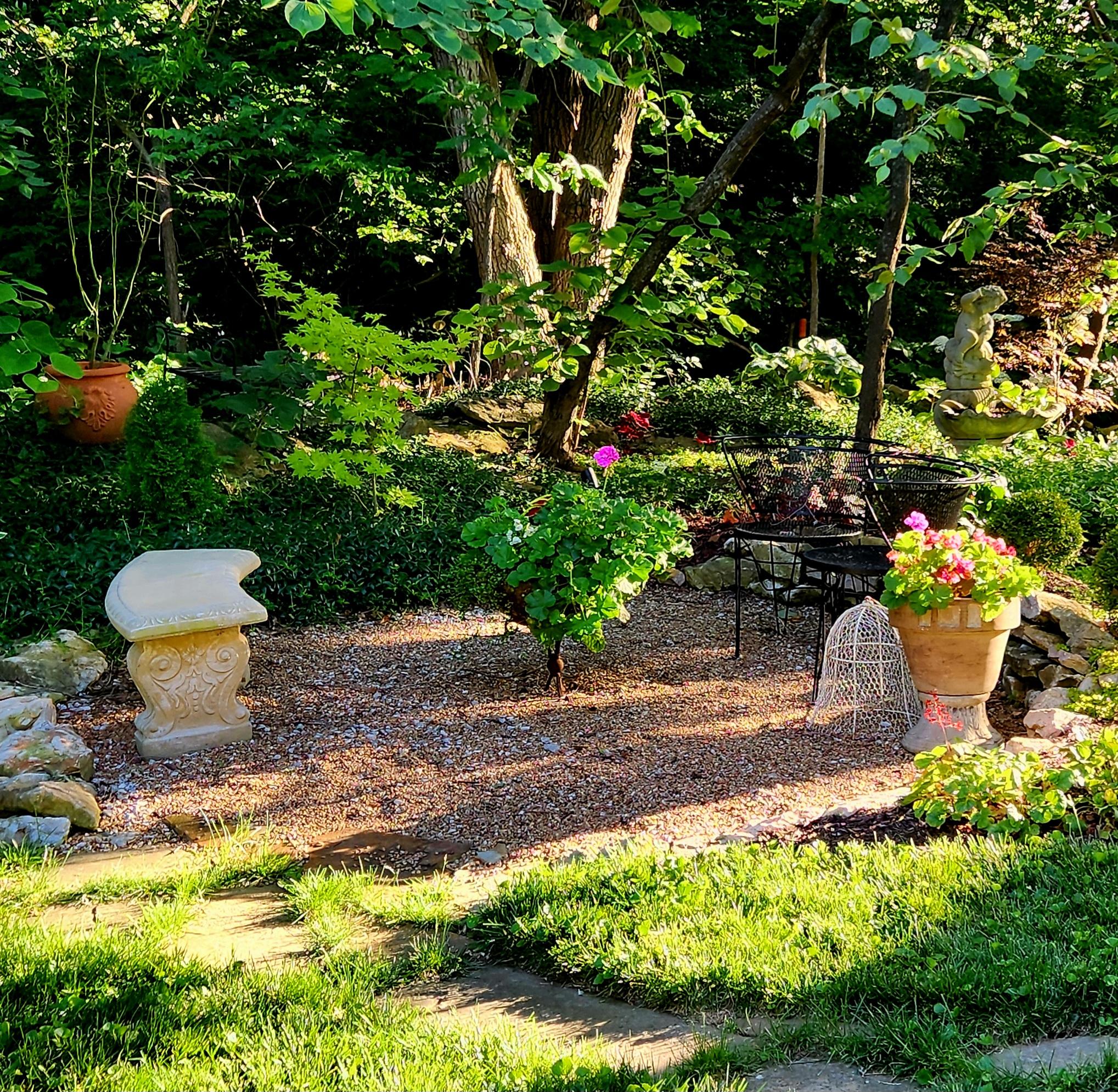
Woodland Retreat or Cottage Garden
Part English cottage garden and part woodland retreat, the gardens surrounding Kate Wilhoft’s home showcase native plants, drought-tolerant perennials, an abundance of colorful flowers, and vegetables. A fence protects the lettuce and peas in the front-yard potager garden from hungry critters; the summer vegetables include tomatoes, cucumbers, pole beans, and raspberries. The garden incorporates stones and curved edges for a natural appearance.
Changes this year include the removal of a massive cottonwood tree. “I replaced it with a narrow columnar maple, but as we wait for that to fill in, I plan on planting snapdragons, salvia, celosia, and ageratum in the area,” Kate says. She’s also planning to add a seven-son flower tree.
A natural creek—complete with a waterfall—graces the backyard. “While our lot is 12,000 square feet, the creek has a steep rocky hill that I can’t garden. So the workable area of my backyard is quite small,” she says. Kate hopes it inspires visitors with small spaces to see what can be accomplished with limited space.
Hydrangeas of every variety blanket the backyard garden. Katie also favors Annabelles, brunnera, hostas, Solomon’s seal, Japanese maples, and coleus. She incorporates vertical elements like homemade trellises since space is limited. Shrubs are layered with vines while groundcovers cascade over boulders and rock walls, infusing green into barren areas.
“I don’t grow rare and unusual plants,” she says. “I focus on plants that are easy to grow in our area, and I try to make them look special with how they’re used. For example, in colorful combinations with other plants.”
Kate’s background in fashion design helps her plan and sculpt her gardens, and she says the gardens still fit with her art and design background.
“I consider gardening to be a special kind of art,” she says, “where you have your plans but God does his part too. I give Him the credit for all my happy accidents.”
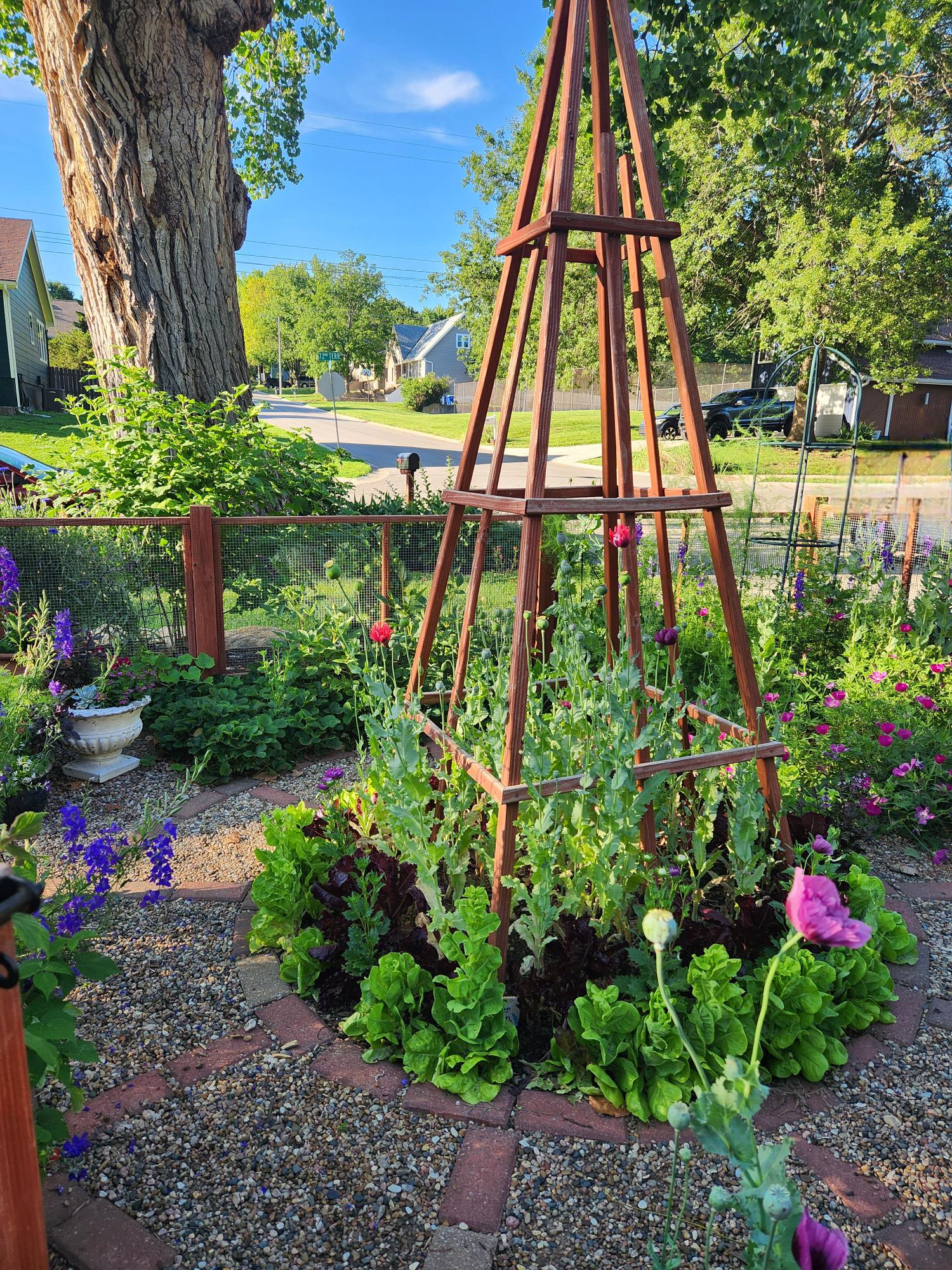
The Garden Club of Shawnee supports efforts to beautify the community and educate and inspire gardeners of all ages.
Tickets for the tour are available for $15 from garden club members or through Eventbrite, accessible via the club’s website at www.gardenclubofshawnee.org. Starting May 1, ticket prices will increase to $20 and can be purchased from club members, Eventbrite, Family Tree Nursery in Overland Park and Shawnee, Wild Birds Unlimited in Shawnee and Olathe, and Earl May Garden Center in Shawnee.
In addition to the tour, the not-for-profit club holds a raffle—with prizes donated by local businesses—and uses the proceeds for its grant program, which assists other nonprofits with projects such as neighborhood food gardens. The club also provides scholarships.
Raffle tickets can be purchased at each garden on the tour (cash only) for $2 each or three tickets for $5.






